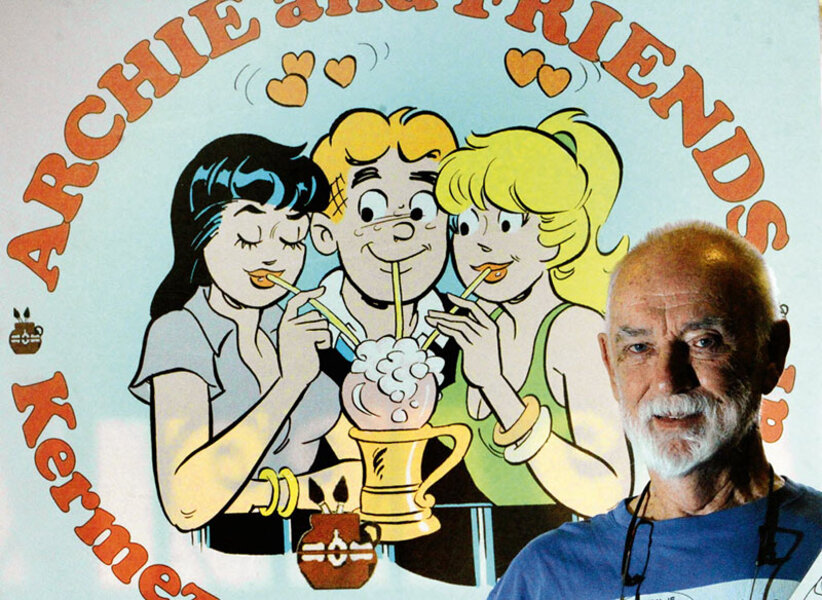Artist behind 'Archie' comics dies. What has fictional red-headed teen meant to readers?
Loading...
Artist Tom Moore, who was one of many artists to contribute to the long-running teen comic series, from 1953 until the late 1980s, died in El Paso, Texas on Monday, National Public Radio reports.
"He's a legend, in El Paso and, really, around the United States," All Star Comics & Games owner Brad Wilson told the El Paso Times. "A lot of people don't realize how much he influenced comic book art."
Moore began his cartooning career in the US Navy when he got caught drawing a caricature of his captain. Instead of getting in trouble he got an assignment as a staff cartoonist, the El Paso Times reported.
Moore would contribute to the series for almost three decades. He typically drew one-page gags and inked the Jughead series, say sources at Archie Comics. [Editor's note: This story originally misstated the extent of Moore's contribution to the "Archie" series.]
Annual sales used to surpass half a million copies during the 1960s, according to the El Paso Times.Now, single-issue sales are closer to a few thousand, The New York Times noted. But it continues to elicit nostalgia among its readers.
Over the last few years, Archie comics and its fictional town of Riverdale have reflected contemporary issues.
In 2010, Riverdale introduced its first openly gay resident, Kevin Keller, The Washington Post reported.
The trend towards LGBT inclusion is not uncommon in the comics industry today.
The New York Times recently reported on DC comics' attempt to become more LGBT-friendly: “Part of [their] overhaul included creating a series for a gay superhero named Midnighter, a character [whose] popularity stems in part from efforts to make his sexual orientation just one aspect of his character.”
In 2014, Archie died when he jumped in front of a bullet intended to hit Keller, who had become a senator pushing for gun control, according to the El Paso newspaper.
The El Paso Times noted the tragedy took place in an alternate “Life with Archie series” so the teenager is still alive in his original self-titled comic.
But Moore disagreed with the decision to kill off Archie. He told the El Paso Times he thought it was motivated by “free publicity” and said “it is kind of sad that the idealistic world of Riverdale is turning so dark with violence, death, and murder.”
Over the decades, Archie comics didn’t typically veer away from stories about high school, pranks, and dating to tackle politics.
An Atlantic Magazine article by Noah Berlatsky notes, “In the 1960s, feminism and the civil rights movement barely register in Riverdale, where there is no past, and therefore no progress. Timelessness, in the Archie comics, was conservative.”
Comics scholar Bart Beaty told The Atlantic, “the comics lack any real sense of continuity.”
The imaginary universe’s timeless paradigm may also have a philosophical significance.
“The Archie gang lack the realism of memory, but in compensation are given the vacuous realism of inconsequence,” Berlatsky wrote. “The lack of continuity provides Archie with the realism of mundanity.”
Publishers recently rebooted Archie with a bold new look.
Quartz reports: “The tone of the new comic is undoubtedly darker. Gone are the poppy, bright colours of the old Archie. The teenager we meet in Staples’ pages is leaner, plays a mean guitar and has the kind of gorgeous finger-comb that a One Direction member would envy.”
Matt Evanier, a comic book historian, told The New York Times, “it’s nice that the folks at Archie have met this problem head-on because to not do anything would give them a greater problem: it would make them irrelevant and corny, like a 1950s hygiene movie.”
But not everything will change.
New artist Fiona Staples, told the A.V. Club Jughead still has his sweater and hat, Reggie still wears a leather jacket and Betty is usually in a t shirt and jeans. “There’s a lot of callbacks to their trademark looks and just minor updates of what’s in fashion” Staples said.
Moore’s legacy may still stay intact.
Jon Goldwater, CEO of Archie Comics, told The New York Times the company wants to “keep the lighthearted and family-friendly tone, but we have to do it in the present times, and that forces us to change.”







